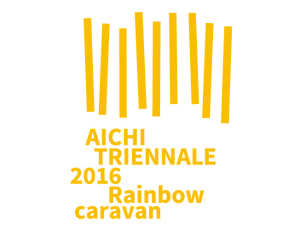Aichi Triennale 2016
Homo Faber: A Rainbow Caravan
Artistic Director: Chihiro Minato
Date: summer –autumn 2016
Concept
The theme I would like to propose for the 3rd Aichi Triennale is humankind’s creative journey—or “caravan”—to the unknown, the kind of journey that invariably takes the form of an endless quest driven by curiosity.
The man-made objects currently on the furthest expeditions from the Earth are space probes launched by the United States. Space probes Voyager 1 andVoyager 2, both launched in 1977, carry a metal disk known as a Golden Record, which contains greetings in 55 languages, music from many different cultures, as well as sounds and images sampled from nature. Given that it will probably be another 40,000 years before either Voyager comes close to any star outside the solar system, no one knows what state the Earth will be in if or when it receives any message from extraterrestrial life. In his Voyager Spacecraft Statement, the then U.S. President remarked, “We hope someday, having solved the problems we face, to join the community of galactic civilizations.” I doubt that there is yet any member of such “a community of galactic civilizations” capable of assuredly identifying the problems we have managed to solve in the ensuing years. Yet still, the curiosity-driven human journey into the unknown carries on, through fathomless time and distance.
If we turn our attention in the opposite chronological direction, we find some of the oldest surviving artistic creations by humans in the gloom of caves dating back some 35,000 years. These creations are images of various animals, in other words, non-human life. Human curiosity about non-human presence, and the connection between humans and non-human presence are evident in all subsequent forms of art. Sound, rhythm, color, gesture—art has identified orders in nature, and has combined and modified natural elements in pursuit of orders not found in nature. But between art and the natural world, there have always been interactions mediated by intellect and sensitivity. What would happen if this interaction became disrupted, separating intellect from sensitivity? It would probably cause the unilateral subordination of nature to the intellect, an absolute breakaway of human beings from the rest of life on Earth, a loss of the connection between life and land, and most seriously, the detachment of human beings from human nature itself.
Natural science recognizes a multicolored spectrum in white light; mythological traditions the world over discuss dragons stretching across the sky; poetry identifies emotion in light; while music hears gradations in light—all these are human interpretations of the rainbow. One wonders what kind of innovative vision humans—who have thus devised songs, dance, words and images from the myriad of sounds and colors identified in non-human presence—will have created by 2016. I am confident that Aichi, which has maintained and constantly reinvented a rich tradition of arts, entertainment and skills shaped over the ages by the ever-evolving local cultural climate, will provide an ideal stage for this international art festival, proposing the advancement of innovation to a global audience.
Aichi Triennale is a rare international art festival in that it aims to showcase, in the most integrated manner possible, the artistic activities of our times, including but not limited to visual art, moving images, music, performing arts, and opera. As such, it offers a prime opportunity to rediscover the connection with nature intrinsic to art since long before it branched into specialized genres. It also provides an open, festive forum for contemporaries to uninhibitedly exchange ideas and knowhow through the vehicle of creation, and share inspirational moments.
Art is a journey into the unknown. Human activity is likewise an expedition into uncharted territory. An art festival is also an undertaking analogous to a journey. Taking on board many, many people, it is an expedition caravan that travels across all sorts of borders in search of the next resonances and shapes. Let us make a “golden record” of our times ourselves. Wherever exhibitions, theater performances, and other colorful events happen, bringing together curiosity-driven individuals from all walks of life, will stand for our caravanserai, where we recover from the day’s journey and prepare for the next journey to the unknown.
The creative caravan departs, loaded with unbounded imagination.
Aichi Triennale 2016 Artistic Director
Chihiro MINATO


